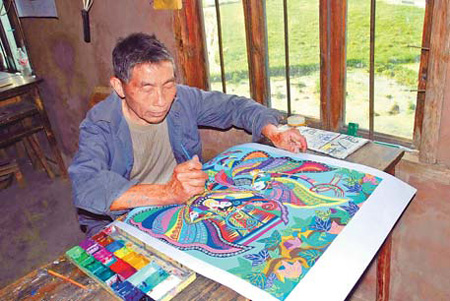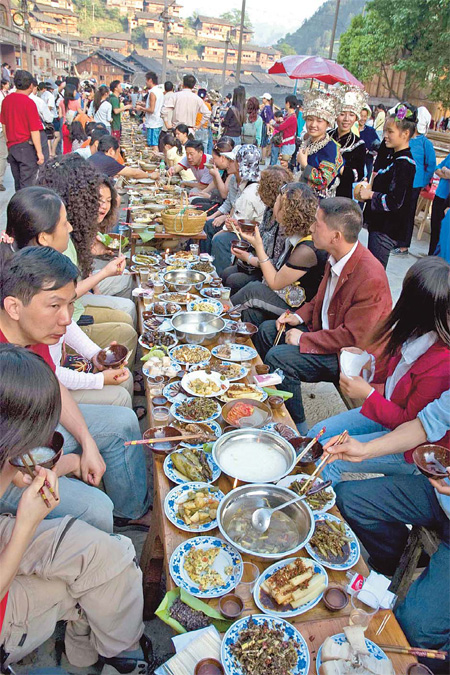Society
Modernity can be two-way street for cultural heritage
By Hu Yongqi (China Daily)
Updated: 2010-11-03 08:17
 |
Large Medium Small |
Turning to tourism
 |
|
Zhao Yuanqiao, an artist in Tonggu village, puts the final touches to his watercolor painting. Zhao is one of the few remaining artists in the village. [Chen Peiliang / for China Daily] |
Mandong village, which is 45 kilometers from Kaili and home to 1,700 Miao people, is already reaping the benefits of using its traditional industry to develop tourism.
Women here have been weaving for more than a century. Using various fabrics and silk, they immerse their products in a dyestuff abstracted from the root of a indigenous tree, then air them out in sunlight for several days. The whole process takes about 10 days.
"The loom is one of my good friends," said Pan Ying, 46, as she pinned her hair into a knot at the back of her neck in typical Miao style. "We have worked together for more than 25 years."
Even as late as the 1990s, almost 100 percent of the garments worn by villagers were homemade. Most products that run off the looms now, however, are sold to tourists.
"Many visitors are attracted by our traditional culture, which has been well preserved," said Pan, director of the village's women's committee, who explained that she weaves with the same machine her mother used for some 50 years.
For weavers in Mandong, the tourism industry that has been gradually developed since 1983 represents an extra 5,000 or 6,000 yuan a month, roughly one-third of the average income for each household.
Although business opportunities abound, the changes have failed to convince many of the village's young people to take up the handicraft.
Like in Tonggu, the lure of the big cities is proving too strong.
In the past, weaving was "a skill girls needed to have before they got married", said Pan. But things have changed and in the past two decades the number of women working the looms plummeting from 700 to just 200.
 |
|
Tourists enjoy a traditional banquet at a Miao village in Leishan county, Guizhou province. The unique culture of the Miao and Dong people attracts more visitors every year. A total of 39 traditions are already recognized as intangible cultural heritage at national level, with another 124 at provincial level. [Chen Peiliang / for China Daily] |
A life in pictures
TONGGU, Guizhou - Even at the age of 75, Yang Guangying maintains the same enthusiasm for painting that she had when she first picked up the brush.
"It has become a lifelong hobby," said the grandmother. "I'll probably not stop painting until my heart stops beating."
Yang joined the ranks of amateur artists almost 30 years ago, going on to become one of the most famous in Tonggu, a village in Guizhou province known for traditional ethnic Miao watercolor paintings.
For many years she actually had no interest in the handicraft, she said, "but I tried it and by the time I'd finished my first painting - it took five days - I was hooked".
Shortly after taking up painting, in 1982 one of Yang's artworks, The Spring to Miao Families, was successfully recommended by Guizhou's cultural bureau to be displayed at the National Exhibition for Rural Paintings. She was the only female artist featured in the show.
Today, the walls of her home are decorated with more than 10 awards, won either in State or provincial-level competitions.
Zhao Wei, her son, told China Daily that Yang paints 30 to 40 pictures a year, each of which sells for between 50 and 1,500 yuan ($7 to $220). He said the extra income paid for the family's new two-story house in 2005.
In 1994, a British tourist paid 750 ponds ($1,200) for two of Yang's paintings during a visit to the village. Since then, at least 100 foreign tourists have bought her work.
"Foreigners like the paintings because they're unique," said Zhao proudly, "but we see the paintings as a way of exchanging (our culture) to those appreciate it."
Smiling, he explained that most buyers also follow the Miao tradition of sharing some locally brewed alcohol with Yang's family. "They often get drunk," he said.
China Daily